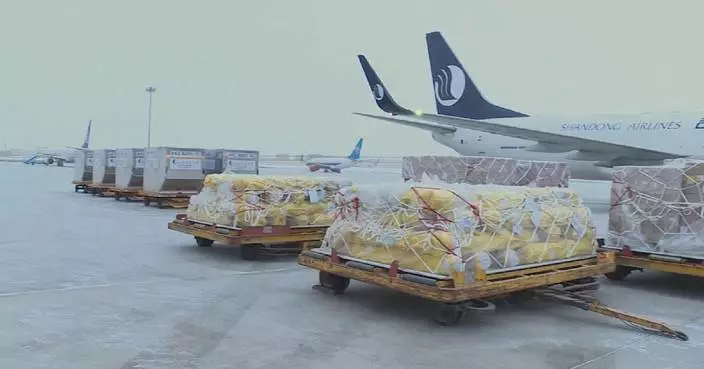Senior executives from international broadcasting associations and mainstream media professionals expressed their eagerness for Global South countries to make stronger voices in world affairs at the 12th Global Video Media Forum (VMF) held in east China's Fujian Province on Tuesday and Wednesday.
The two-day forum brought together about 200 representatives of mainstream media and international organizations from more than 60 countries and regions to the coastal city of Quanzhou, a historic trading port and UNESCO World Heritage site.
The forum launched the "Joint Initiative for Dialogue and Cooperation of Global South Media", which aims to build a global South narrative system, expand its media voice, enhance mutual learning and exchanges, and promote the common prosperity of global South civilizations.
In a special dialogue session for Global South media on Tuesday afternoon, media leaders from countries and organizations put forward their views on how to better tell the story of the Global South.
Ahmed Nadeem, secretary-general of the Asia-Pacific Broadcasting Union, said that the Global South media should develop creative content delivery methods to showcase their diverse cultures.
"There is a huge demand for content. And one way we can answer this demand is looking at our strengths as broadcasters, as media practitioners, as media entities, because what we have and the strongest strength we have is developing content. So, that's the area that we have been very, very strongly advocating. There's a lot our countries have in common. And I think, one of the ways that we can showcase our diverse cultures is by developing creative ways of developing content that are of interest to others and share this content through mediums that are available to us," he said.
Abdelrahim Suleiman, director-general of the Arab States Broadcasting Union, said that strengthening media cooperation in the southern hemisphere is an opportunity to connect the Arab world and unite all developing countries for common development.
"We have already had clear mechanisms for communication and platforms for exchanges between different regions across the world, including Africa and Asia, as well as Arab countries and China. We hope to have some clearer mechanisms to connect them," he said.
Meanwhile, Gregoire Ndjaka, CEO of the African Broadcasting Union, said that the media should play a greater role in filling the knowledge gap between people of different backgrounds.
"We are telling our own stories, which means that we Global South countries need to share stories that are relevant to us, focusing on issues that are practically and directly related to us, such as the promotion of our own culture. In today's world, in the tide of globalization of knowledge and communication and the collectivization of information, there exists a cognitive gap that needs to be bridged," said Njaka.
Juan Carlos Isaza, managing director of the Latin American Information Alliance (AIL), said the alliance is ready to expand cooperation and share its news resources with more global partners.
"The Global South seeks integration and cooperation among the developing countries in the Southern Hemisphere. The born of AIL was driven by the need for media outlets from Global South countries to report on common topics and issues for their audiences, with a commitment to providing timely, efficient, professional and responsible reporting," said Isaza.
Neville Choi, board director of the Pacific Islands Press Association, pointed out the emergence of new technologies such as artificial intelligence, but said that countries in the Global South should always be committed to promoting their cultural heritage.
"Throughout the region, we are looking at maintaining human oversight over everything. That's important in our newsrooms. We do have a strong environmental focus in the region. And of course, now that the media in the Pacific is again united, our perspective now is we will be looking at our cultural heritage, because that's the foundation where we come from. And in the Pacific, we are tied to our oceans, we are tied to our forests, and we are tied to our land, so we are open to work with anybody in the Global South to help promote that," said Choi.
Ian Phillips, director of the News and Media Division of the United Nations Department of Global Communications, also attended the meeting. He said that the media needs to increase investment in the Global South and called for the world to "rebalance". The UN official also urged developed countries to provide more support to the Global South on key issues such as climate.
"My own googling research showed that 80 percent of the world population, if you can believe what you read on the Internet, is from the Global South, and that they're responsible for 40 percent of GDP. And yet, it's so underrepresented, and it deserves more coverage, and it deserves more of a say. The current reality where the Global South is paying the price of what other parts of the world have created, for example, climate, is grossly unfair. And at the UN, the secretary general and the deputy secretary general often talk about this. They say there has to be a rebalancing. There has to be more means given to the Global South. The rich industrialized world has to do that," he said.
The forum was hosted by China Central Television Video News Agency (CCTV+) with the theme of "Wisdom without Borders, Vision without Boundaries-The Role of Media in Communication and Cultural Exchange". The forum also conducted in-depth discussions on the application and governance of artificial intelligence technology in the media field.
The Video Content Forum was founded by CCTV+ in 2011 and has grown into a top platform for global media professionals to discuss the latest trends in video content dissemination and innovation, aiming to promote more interaction and cooperation between domestic and foreign media.

Int'l media leaders explore ways for Global South countries to make stronger voices in world affairs









